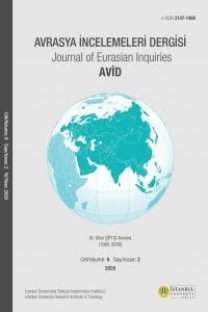Eski Türklerde Şehir Yapısı ve Kültürü Üzerine Bazı Değerlendirmeler
Türkistan sahasındaki eski şehirler esasen “feodal şehir yapıları” olarak tasnif edilmiştir. Feodal şehrin temel unsuru, şehrin etrafını kuşatan ve şehri dış düşmanlardan, diğer feodal güçlerden, bozkırlılardan, köylüden, çiftçiden vb. ayırmak için dikilen duvar veya surdur. Şehrin dinamiği- yâni onun inşası, yıkılması ve yeniden inşası- şehrin veya bölgenin siyasi ve toplumsal hayatı ile doğrudan bağlantılıdır. Bu yüzden kale, duvar vb. yapılar şehrin geçmişi ve kültürü hakkında bilgi vermektedir. Eski Türkistan şehirlerinde kaleler, hisarlar, yoğun nüfusun küçük alanlarda yaşadığı iç şehirler, dar sokaklar, pazarlar, ibadethaneler, türbeler, kamu binaları, tezgâhlar, şehrin dış mahallelerinde zanaatkârların, işçilerin meskenleri, mezarlıklar, dış halkada tarım üretimi yapılan bağlar-bahçeler-tarlalar, hayvan otlakları ve bunlarla meşgul olan nüfus vardı. Şehirler genelde ihtişamlı tahkimatla çevriliydi. Bu şehirlerde düzenli planlar ve şehir nizamını sağlayan görevliler vardır. İnsanların ve malların yığılması ile bitişik türlü meskenlerin artması sadece idare ve kültürün gelişmesini değil aynı zamanda zanaat ve ticaret hacminin büyümesiyle şehir yapısında geniş meydanları ortaya çıkarıyordu. Eski Türk şehirleri üzerine bu bildirimizde Türklerde şehir mefhumu ile şehrin fiziki yapısı, mekanları, planı, kısımları, savunma sistemleri, toplumun ruhuna ve sanata tesirleri gibi konular üzerine değerlendirmeler yapılacaktır. Böylece Türkiye şehir kültüründeki köklü Türkistan mirası üzerinde durulması hedeflenmektedir.
Some Evaluations of Ancient Turks’ City Culture and Structure
Ancient cities in the Turkestan area are essentially classified as “feudal city structures”. The basic element of the feudal city is the wall that surrounds the city and is erected to separate the city from external enemies, other feudal powers, steppe peoples, peasants, farmers, etc. The dynamics of the city- that is, its construction, demolition, reconstruction- is directly linked to the political and social life of the city or region. So, structures such as castles, walls, etc. provide information about the history and culture of the city. In old cities of Turkestan there were castles, fortresses, densely populated inner cities, narrow streets, markets, places of worship, shrines, public buildings, looms, dwellings of craftsmen and workers, and cemeteries in the outskirts of the city. In the outermost ring, there were vineyards, gardens, fields, animal pastures and population engaged in agricultural production. Cities were often surrounded by magnificent fortifications. These cities had regular plans and an official who maintain the city order. The accumulation of people and goods and the increase of adjacent dwellings did not only reveal the development of administration and culture, but also the growth of craft and trade, and large squares in the city structure. In this paper on ancient Turkic cities, evaluations will be made on issues such as the notion of the city in Turks and physical structure, places, plan, parts, defense systems of the city, city’s effects on the spirit and of society and art. Thus, it is aimed to focus on the enormous Turkestan heritage in city culture of Türkiye
___
- Barthold, V. V., Moğol İstilâsına Kadar Türkistan, Haz., Hakkı Dursun Yıldız, Ankara, 1990. Baykara, Tuncer, “Türk Hayatında Şehir ve Cumhuriyet Devri Gelişmeleri”, Erdem, XI, 32, 1998. google scholar
- Bilgiseven, A. K., Genel Sosyoloji, Filiz Kitabevi, İstanbul, 19864. google scholar
- Büchner, V. F., “Şehir”, İslam Ansiklopedisi, XI, Eskişehir, 2001. google scholar
- Esin, E., “Orduğ (Başlangıçtan Selçuklulara Türk Hakan Şehri)”, DTCF Tarih Araştırmaları Dergisi, VII/10-11, 1968. google scholar
- Gelah, T. F., “K Voprosu İzuçeniya Krepostnıh Sten Feodalnogo Goroda Sredney Azii”, Uçenıye Zapiski, Vıp. 10, Buhara, 1961. google scholar
- İbn Haldun, Mukaddime, C. II, Çev., Z. Kadiri Ugan, M.E.B. Yay., İstanbul, 1996. google scholar
- Kâşgarlı Mahmud, Divanü Lûgat-it-Türk, C. I, Çev., B. Atalay, Ankara, 2006. google scholar
- Mukaddesî, İslâm Coğrafyası (Ahsenü’t-Takâsîm), Çev., D. Ahsen Batur, İstanbul, 2015. google scholar
- Kafesoğlu, İbrahim, “Türk Devleti”, Umumî Türk Tarihi Hakkında Tespitler, Görüşler, Mülâhazalar, Ötüken Yayınları, İstanbul, 2014. google scholar
- Kızlasov, L. R., Gorodskaya Tsivilizatsiya Sredinnoy i Severnoy Azii, Moskva, 2006. google scholar
- Narşahî, Târih-i Buhârâ, Farsçadan Trc.: Erkan Göksu, Ankara, 2013. google scholar
- Semenov, G. L., Sogdiyskaya Fortifikatsiya V-VIII Vekov, Sankt-Peterburg, 1996. google scholar
- Sümer, Faruk, Eski Türklerde Şehircilik, Ankara, 1994. google scholar
